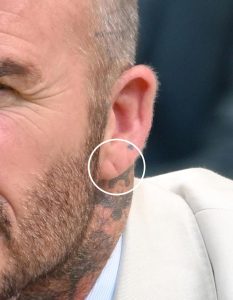David Beckham: Experiencing facial diagonal wrinkle known as – Frank’s Crease: a subtle sign that Sparked a Cardiologist’s Concern

When a Lithuanian cardiologist recently spotted a faint diagonal line etched into David Beckham’s right earlobe, he saw more than a small mark. To him, it was a subtle but unsettling warning, one that has, for decades, intrigued and divided the medical community.

The crease, known as Frank’s Sign, was first described in 1973 by American physician Dr. Sanders T. Frank, who noticed that many patients with heart disease shared the same diagonal wrinkle across one or both earlobes. Over time, researchers have explored its potential link to atherosclerosis, a condition in which fatty deposits build up inside arteries, narrowing them and raising the risk of heart attack or stroke.
Cardiologist Dr. Rokas Šerpytis, who noticed the crease while watching Beckham on television, said the observation immediately caught his attention. “It may seem like a small detail,” he told Lithuanian media, “but such details can sometimes reflect deeper health concerns.” His concern grew after learning that Beckham’s father, Ted Beckham, suffered a heart attack in 2007 — a reminder that family history remains one of the strongest predictors of cardiovascular risk.
Science, however, remains cautious. While a 2021 Oxford University study referred to the earlobe crease as a potential “dermatological marker for coronary artery disease,” it also emphasized that the relationship is not conclusive. Many doctors warn against reading too much into a single physical sign.
“There’s no strong physiological reason to think a skin fold directly signals heart disease,” said Dr. Paul D. Thompson, Chief Cardiologist-Emeritus at Hartford Hospital. “I’ve never used Frank’s Sign in my practice. We have far more reliable methods of assessing heart health.”
Indeed, cardiologists rely on a suite of established diagnostic tools — from blood pressure checks and cholesterol tests to ECGs, echocardiograms, and thorough family histories. These are the gold standards in identifying who’s truly at risk.

Still, the fascination with Frank’s Crease persists. Stanford Medicine has noted that the wrinkle appears more frequently in patients who have undergone coronary bypass surgery, hinting that it could serve as a subtle, if imperfect, visual cue for doctors.
Whether or not the crease holds diagnostic power, Dr. Šerpytis says the sight of it on Beckham serves as a public reminder that even the fittest among us aren’t immune to heart disease. Now 50, Beckham is celebrated for his enduring athleticism and clean lifestyle — but genetics, stress, and age all remain powerful forces.
Heart disease continues to be the leading cause of death worldwide, claiming an estimated 17.9 million lives each year, according to the World Health Organization. Subtle warning signs from elevated cholesterol to unexplained fatigue often go unnoticed until it’s too late.
For families like the Beckhams, the story underscores the importance of vigilance. Regular screenings, a balanced diet, and open conversations about family health history can make a life-saving difference.
“Sometimes, our bodies whisper before they shout” said Dr. Šerpytis,










I’m not that much of a online reader to be honest but your blogs really nice, keep
it up! I’ll go ahead and bookmark your website to come back down the road.
All the best
Hello there, just became aware of your blog through Google, and found
that it’s truly informative. I am gonna watch out for brussels.
I will be grateful if you continue this in future.
A lot of people will be benefited from your writing.
Cheers!